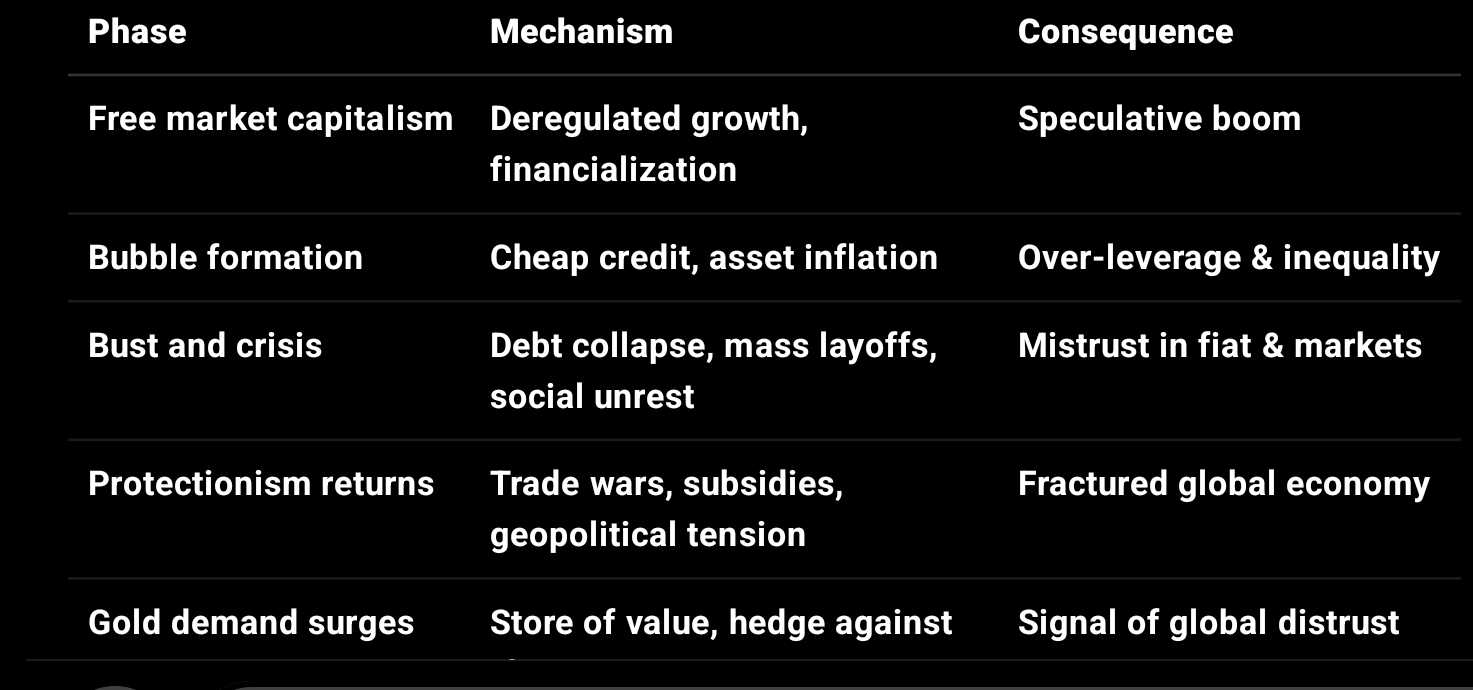🌍 From Capitalism to Chaos: How the Free Market Breeds Crises, Inequality, and Gold Fever
Introduction
Capitalism and free markets have long been hailed as the engines of global prosperity. They’ve unleashed innovation, lifted billions from poverty, and transformed societies. Yet, beneath the surface lies a system driven by accumulation, competition, and speculative cycles—one that, left unchecked, repeatedly implodes under its own contradictions.
From speculative bubbles to deep recessions, from wealth polarization to geopolitical conflict, the inherent logic of capitalism sets the stage for boom-bust crises, socioeconomic fragility, and a growing flight to gold—the age-old symbol of stability amid uncertainty.
---
1. 🔁 The Boom-Bubble-Bust Logic of Capitalism
A. The Boom Phase
Under free-market capitalism:
Credit expands, banks lend aggressively, and corporations invest in new markets.
Consumer demand rises, asset prices surge (stocks, housing, crypto), and GDP grows.
Optimism fuels speculative risk-taking—often disconnected from real productivity.
B. The Bubble Phase
As credit and capital concentrate:
Asset inflation accelerates beyond fundamentals.
Investors chase returns, ignoring systemic risk.
Regulation often loosens under political and corporate pressure.
A feedback loop of rising prices and easy money creates bubbles.
> “The capitalist economy is inherently unstable and tends toward boom and bust.” — Hyman Minsky
C. The Bust Phase
Eventually:
Debt becomes unsustainable.
A shock (e.g., rate hike, geopolitical conflict, pandemic) triggers a loss of confidence.
Investors panic, credit dries up, assets crash, and businesses fail.
Governments intervene—too late or in ways that protect capital more than labor.
Examples:
2000 dot-com bubble
2008 global financial crisis
2020 COVID + 2022 inflation shock
The system resets, but the core instability remains—often worse than before.
---
2. 📉 Capitalism’s Inevitable Outcome: Widening Inequality
Capitalism’s core engine runs on:
Private ownership of capital
Market-based wage determination
Competition and profit maximization
This creates a structural imbalance:
A. Capital vs. Labor
Capital earns passive returns (dividends, interest, asset appreciation).
Labor earns wages, often stagnant in real terms.
Wealth compounds faster than income: Piketty’s r > g.
B. Financialization
Speculative finance overshadows productive investment.
Wealth flows to those already owning assets.
Stock buybacks, IPOs, and speculative trading inflate financial wealth, not real economic output.
C. Policy Capture
Deregulation, tax loopholes, and lobbying preserve elite interests.
Social safety nets are hollowed out in favor of market "discipline".
> Result: The rich get richer during booms. The poor suffer most in busts.
---
3. 🌍 Globalization, Complexity, and Fragility
A. Free Market Globalization
Countries integrate into hyper-competitive supply chains.
Corporations chase cheapest labor, lowest taxes, and weakest regulation.
Local economies and small producers are outcompeted or absorbed.
B. Fragile Interdependence
Global markets become highly efficient—but also brittle.
Crises in one country (e.g., China lockdowns, Ukraine war) disrupt entire systems.
C. The Return of State Power
As global free markets begin to falter, nation-states reassert control:
Food, energy, semiconductors, and data become geostrategic assets.
State subsidies, trade restrictions, and national champions re-emerge.
---
4. ⚔️ The Drift Toward Mercantilism and Trade War
A. Neoliberal Capitalism Breaks Down
When growth stagnates, countries turn inward:
Protect domestic industries from foreign competition.
Weaponize trade and technology (e.g., chip bans, export controls).
Subsidize "national champions" (e.g., EVs, green tech, arms).
This is neo-mercantilism:
> Trade becomes a tool of power, not efficiency.
Examples:
U.S.–China trade war
EU–U.S. subsidy battles
BRICS currency blocs
Sanctions on Russia/Iran/Venezuela
The “free market” transforms into a battleground where states fight for security and dominance—not cooperation.
---
5. 🤝 Mistrust, Institutional Breakdown & Social Fracture
A. Economic Mistrust
Collapse of belief in fiat money, central banks, and “soft landings”.
Sovereign debt crises looming (e.g., U.S., Italy, Japan).
Inflation erodes middle-class savings; the poor lose purchasing power.
B. Political Mistrust
Voter anger over inequality fuels populism, nationalism, and authoritarianism.
Institutions lose credibility amid scandal, dysfunction, and elite impunity.
C. Social Mistrust
Communities fragment under stress.
Work becomes precarious; housing and healthcare unaffordable.
Generational inequality explodes.
---
6. 🟡 The Rise of Gold: Safe Haven in a System of Distrust
Why gold?
No counterparty risk
Not tied to any one government or currency
Trusted store of value for millennia
As institutional, economic, and geopolitical trust erodes:
Central banks stockpile gold (esp. in China, Russia, Turkey, India).
Retail investors flee fiat currencies and risk assets.
Gold ETFs and bullion see record inflows.
What gold signals:
A vote of no confidence in paper money and political stability.
A return to material value over abstract, leveraged financial instruments.
A hedge against systemic collapse.
> The higher the gold price, the deeper the fear beneath the surface.
---
📊 Final Summary: The Capitalist Loop to Gold
see picture attached
---
🧭 Final Reflection
> Gold doesn’t lie. It reflects what markets won’t say out loud.
The surge in gold price is not just about inflation or interest rates. It's a mirror held up to the fractures of capitalism—a system that breeds inequality, cycles of destruction, and eventually, the erosion of social trust.
As people and nations turn to gold, they’re not just hedging assets. They're signaling a collective fear: that the system we’ve built is no longer safe, no longer fair, and no longer sustainable.
The question is not whether gold will rise—but whether trust in capitalism can be restored.
______
$IHSG $BMRI $CDIA

